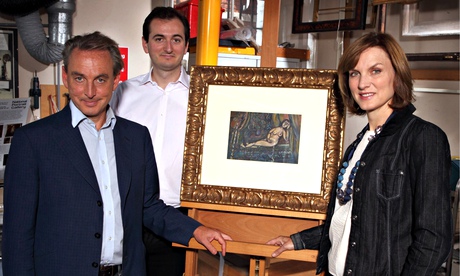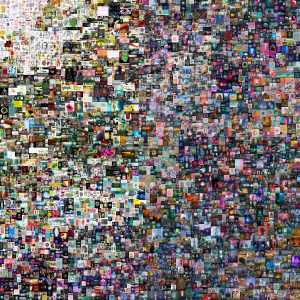
The painting, Nude 1909-10, attributed to Marc Chagall, on Fake or Fortune with (l-r) Philip Mould, Bendor Grosvenor and Fiona Bruce. Photograph: BBC/Glenn Dearing”
Sometimes, the value and the price of an artwork coincide like a total solar eclipse, where an inflated dealer’s head blocks out all the light emanating from the knowledge of an expert, as in the recent case of a fake Chagall. Fake artworks are devastating for the collector and embarrassing for the dealer, but they are good news for the general integrity of art. In this particular matter, we see a splendidly draconian approach to authentication and the victory of art over the market where, as if under emergency law, prices must reflect values.
Twenty years ago, a businessman named Martin Lang invested in Chagall’s Nude 1909-10 for £100,000. A Chagall does not need a pricetag to guarantee its cultural value, for history has seen to it that, although there is a sliding scale of important to minor works, a Chagall is valuable in and of itself as a Chagall. Here the price reflects its being a minor work, but also a doubt over the painting’s authenticity, which must have been sufficiently minimal in the mind of both dealer and buyer to enable the transaction to go ahead. The estate of Chagall is centrally managed by the Chagall Commission in Paris, but due to his dual heritage, the Russians have a hand in proffering mystifying artworld pronouncements on provenance. This particular painting was purchased from a Russian dealer who waved the wand of authentication on the basis of the picture’s appearance in a Soviet catalogue. So Lang bought the work with the intention of holding onto it until his retirement.
It all went wrong when Lang began to think about selling the painting. He thought it might fetch £500,000, even though, having held on to it and watched the crash-proof market sell Chagalls for $10 million, he dreamt of rather more. One would think that on the advice of an expert and with the attachment one fosters over so many years Lang was fairly sure in his conviction of the work’s authenticity. It was a brush with the normally insipid arts team at the BBC that dramatically changed fortunes. Scrutiny by the Fake or Fortune? experts proved it to be a fake, dashing all hope, demolishing years of pride and subtracting an object from the Chagall corpus.
The fact that fakes appear on the market is a worry because, aside from feeding the capitalist infrastructure, the market does play a very real role in the guardianship and dissemination of artworks. The market ensures the integrity of art insofar it has has the logistical role of moving artworks from one collection to another; as such, it bears a responsibility for both what is exchanged and where it ends up. The moral problem is that forgery is both an artistic and an economic crime. There is a sense in which many are willing to forgive the artistic crime: after the storm has blown over, there is still a work of art, made by an artist, which in itself possesses some of the values of art, and whose entire history now has to be reconstructed.
In an act of breathtaking moralising, the Chagall Committee is now attempting to enact an archaic French law which requires the painting to be extradited to France and burnt in front of a magistrate. It is interesting that they should take such a harsh line to say that since the work is not what it claimed to be, then it is worthless; by extension, since it has the wrong kind of cultural value it therefore has no economic value. This alignment of the two values is particular to the case of fakes, and I think the Committee is right to take this exceptional circumstance to make an important point.
Those opposed to the destruction of the painting will cite the fact that it is still the fruit of someone’s artistic labour and that it is owned (and treated) as an artwork by a loving collector. However, we should not let romanticism get in the way of integrity. An example should be set to those who wish to defame the names of great artists through deception and manipulation. But more importantly, the collision of cultural and economic value is so rare that it should be heeded in earnest because it preserves the integrity of an artworld constantly viewed with suspicion. Just as a solar eclipse provides a haunting moment of calm in the chaos of the Earth, the shock of a fake provides an opportunity to reflect on the rampant bustle of an artworld which is sometimes too quick to make high-minded pronouncements.









